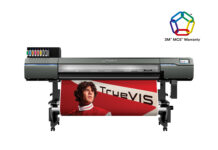When it comes to being a successful film and graphics installer, there are some common pointers you should be familiar with, as well as some items you might not have thought about. All these factors can be combined to improve your film installation work.
- One common mistake with film application is using the wrong tools or neglecting the correct application technique. “If you’re squeegeeing too lightly on a material that is a cast product with the air-egress in it, you’re actually still leaving air in those air channels,” says Ryan Allen, regional technical specialist at Avery Dennison Graphics Solutions.
Spray bottles with surface cleaners (a bottle with 70 percent IPA and a bottle with baby soap) are an essential tool—with a caveat. “Avoid spray bottles that are not of good quality,” advises Allen. “If one breaks and is spraying incorrectly, it will take you longer to fix and clean up rather than spending the extra money on a good, quality bottle from a home improvement store or a window tinting specialty store.”
- Another correctable mistake is inadequate use of the cast or calendared material. “If you’re wrapping a car with bumpers, big corners, deep recesses, etc., it can be challenging using a calendared material in those areas without lifting. Calendared materials always want to pull back,” says Allen. “You can actually re-learn the memory of a cast material by post-heating it up to 180 degrees or higher.”
- Be aware that improper surface cleaning can impede or cause issues with a film’s adhesion. “This involves either not cleaning the surface at all or using improper detergent,” says Allen.
- Vehicles and walls have some distinct differences when it comes to graphics installations onto them.
After all, you can control the environment when wrapping a vehicle in your shop’s bay. But wall graphics require the installer on-site, which could mean being in the middle of a construction zone or around the general public at a shopping center.
Allen advises that, during your site survey for interior graphics, be aware of the texture and condition of the surface of the walls. He recommends bringing a test kit or swatch samples you can obtain from manufacturers and testing on the wall. “That way, you know exactly what you’re getting before installing it on the walls,” he says.
- Floor graphics require you to pay attention to slip resistance and durability, so choosing the right film with the appropriate adhesive and lamination is crucial. “It’s important to check what certifications are needed specific to floors and which films are compliant with slip and scuff,” says Allen, noting that having a laminate that can wipe scuff marks off and hold up to daily walkovers can help you determine if the material is going to make it through the life of an advertising or directional campaign.
Allen advises talking to your customers about environmental services, such as custodians coming through after hours. They might have a detergent or chemical in their cleaning kit that can be harmful to the materials.
“There are instances where people have had floor graphics fade in one corner or issues come up in one section, and for the life of them, they cannot figure it out,” he says. “Then they look back at camera footage and realize that their cleaning crew came through at night with their automatic floor cleaner, running it by that section and causing the failure.”
- Finally Allen recommends having a good relationship with the client where they feel comfortable discussing any concerns (“something not looking right,” “a corner starting to lift,” etc.). “Then you can get in front of the problem and fix it before it becomes catastrophic,” he explains.











